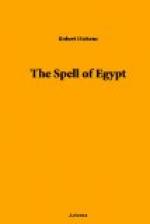But at the end, one can only say that this place is indescribable, and not because it is complex or terrifically grand, like Karnak. Go to it on a sunlit morning, or stand in it in late afternoon, and perhaps you will feel that it “suggests” you, and that it carries you away, out of familiar regions into a land of dreams, where among hidden ways the soul is lost in magic. Yes, you are gone.
To the right—for one, alas! cannot live in a dream for ever—is a lovely doorway through which one sees the river. Facing it is another doorway, showing a fragment of the poor, vivisected island, some ruined walls, and still another doorway in which, again, is framed the Nile. Many people have cut their names upon the walls of Philae. Once, as I sat alone there, I felt strongly attracted to look upward to a wall, as if some personality, enshrined within the stone, were watching me, or calling. I looked, and saw written “Balzac.”
Philae is the last temple that one visits before he gives himself to the wildness of the solitudes of Nubia. It stands at the very frontier. As one goes up the Nile, it is like a smiling adieu from the Egypt one is leaving. As one comes down, it is like a smiling welcome. In its delicate charm I feel something of the charm of the Egyptian character. There are moments, indeed, when I identify Egypt with Philae. For in Philae one must dream; and on the Nile, too, one must dream. And always the dream is happy, and shot through with radiant light—light that is as radiant as the colors in Philae’s temple. The pylons of Ptolemy smile at you as you go up or come down the river. And the people of Egypt smile as they enter into your dream. A suavity, too, is theirs. I think of them often as artists, who know their parts in the dream-play, who know exactly their function, and how to fulfil it rightly. They sing, while you are dreaming, but it is an under-song, like the murmur of an Eastern river far off from any sea. It never disturbs, this music, but it helps you in your dream. And they are softly gay. And in their eyes there is often the gleam of sunshine, for they are the children—but not grown men—of the sun. That, indeed, is one of the many strange things in Egypt—the youthfulness of its age, the childlikeness of its almost terrible antiquity. One goes there to look at the oldest things in the world and to feel perpetually young—young as Philae is young, as a lyric of Shelley’s is young, as all of our day-dreams are young, as the people of Egypt are young.
Oh, that Egypt could be kept as it is, even as it is now; that Philae could be preserved even as it is now! The spoilers are there, those blithe modern spirits, so frightfully clever and capable, so industrious, so determined, so unsparing of themselves and—of others! Already they are at work “benefiting Egypt.” Tall chimneys begin to vomit smoke along the Nile. A damnable tram-line for little trolleys leads one toward the wonderful colossi of Memnon. Close to Kom Ombos some soul imbued with romance has had the inspiration to set up—a factory! And Philae—is it to go?




